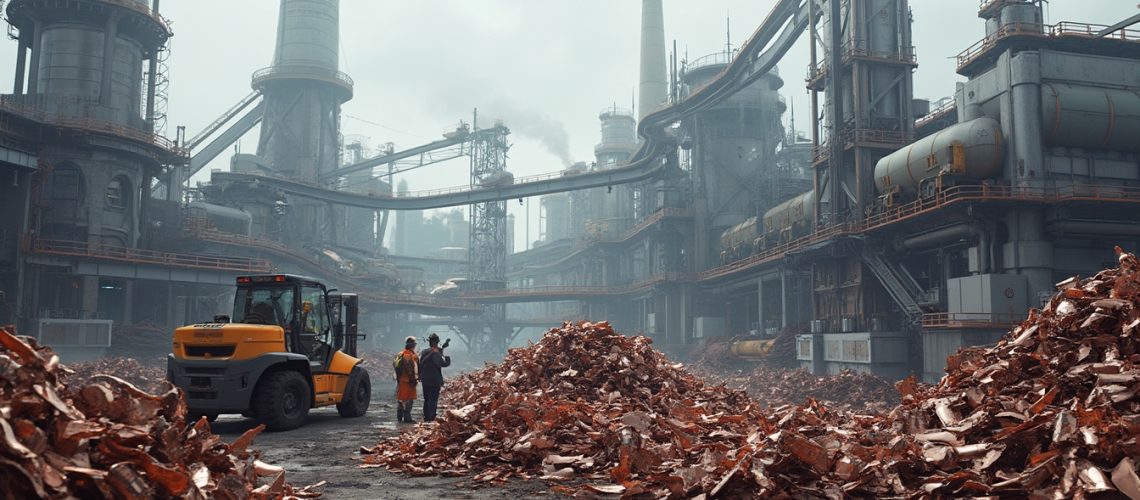Strategic Partnership: Glencore and Cyclic Materials Revolutionise Copper Recycling
The global mining sector is witnessing a transformative collaboration between Glencore and Cyclic Materials, signalling a significant shift towards sustainable metal recycling. This multi-year strategic partnership aims to address the growing demand for copper driven by electrification, renewable energy, and emerging AI technologies.
The partnership represents a critical response to the increasing global need for copper, with supply-demand dynamics becoming increasingly complex. By focusing on recycling end-of-life metals, Glencore and Cyclic Materials are positioning themselves at the forefront of the digital transformation in mining.
Why Is Copper Recycling Becoming Crucial?
Copper has emerged as a critical metal in the transition towards green technologies. The metal's exceptional electrical conductivity makes it indispensable for electric vehicle batteries, wind turbines, and photovoltaic cells. Projections indicate copper demand will surge to 52.5 million tonnes per year by 2050, representing a substantial 72% increase from 2021 levels.
The economic rationale for copper recycling is compelling. Establishing new copper mines requires immense capital investment, often exceeding $5 billion, and can take over a decade to become operational. Recycling offers a more sustainable and cost-effective alternative to traditional mining practices.
The Mechanics of Copper Recycling
Cyclic Materials will supply Glencore with over 10,000 metric tonnes of recycled copper sourced from diverse end-of-life products. These sources include electric vehicle motors, wind turbine generators, and data center electronic waste. The recycling process involves sophisticated techniques to extract copper from complex waste streams.
Glencore's Horne smelter in Quebec, recognised as North America's largest copper and precious metals recycler, will play a pivotal role. The facility will refine the recycled copper scrap into premium copper cathodes, demonstrating advanced metallurgical capabilities.
Market Dynamics and Investment Potential
The copper recycling market presents intriguing opportunities for systematic investing strategies. Current market conditions suggest a potential 1.7% copper supply deficit by 2035, creating a speculative environment that could drive significant investor interest.
Copper prices on the London Metal Exchange have reached record highs of $9,200 per ton in 2024, further incentivising recycling innovations. This economic backdrop makes investments in copper recycling particularly attractive for those seeking global commodities market insights.
Challenges in Copper Recycling
Despite promising prospects, copper recycling confronts several challenges. Regulatory frameworks for mining and recycling vary globally, introducing compliance complexities. Traditional copper mining projects frequently encounter community opposition, as observed in regions like Panama and Serbia.
The recycling process demands sophisticated infrastructure and high-grade raw material inputs. Technological advancements and continuous innovation will be critical in overcoming these operational hurdles.
Environmental and Strategic Implications
Copper recycling significantly reduces the carbon footprint associated with traditional mining operations. By advancing circular economy principles, companies like Glencore are actively contributing to global sustainability objectives.
The partnership between Glencore and Cyclic Materials exemplifies a broader industry trend towards more sustainable resource management. As reported in the original Mining Weekly article, this collaboration represents a strategic approach to addressing future metal supply challenges.
Future Outlook for Copper Recycling
Predictions suggest copper demand will continue outpacing supply, even with advanced recycling techniques. The emergence of AI and electrification industries is expected to create additional speculative markets for recycled copper.
Strategic regional partnerships like this could potentially influence global mining and recycling trends, encouraging other industry players to adopt similar sustainable models.
Conclusion
The Glencore-Cyclic Materials partnership highlights the transformative potential of copper recycling in managing global metal demand. By addressing supply constraints and aligning with environmental, social, and governance (ESG) goals, this collaboration sets a benchmark for sustainable resource utilisation.
As the industry continues to evolve, such innovative approaches will be crucial in supporting global energy transitions and technological advancements.
Ready to Capitalize on Big Discoveries?
Unlock the full potential of mineral investing with Discovery Alert’s cutting-edge, AI-powered service. Receive real-time alerts on the most significant ASX discoveries, providing a clear view into both short-term opportunities and long-term game-changers. Whether you're a seasoned investor or just starting out, our comprehensive reports will help you make informed decisions with ease. Take advantage of our 30-day free trial today and transform your investment strategy with insights from Discovery Alert's dynamic services. Visit Discovery Alert and see the difference.







